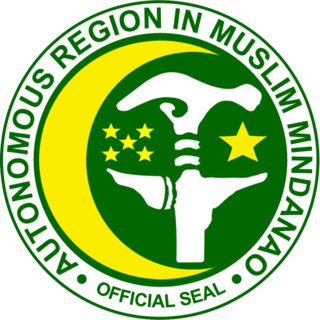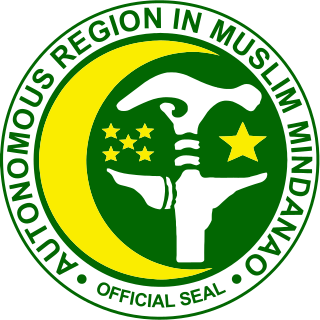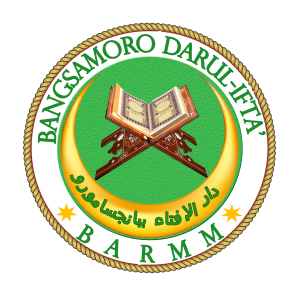
In the Philippines, regions are administrative divisions that primarily serve to coordinate planning and organize national government services across multiple local government units (LGUs). Most national government offices provide services through their regional branches instead of having direct provincial or city offices. Regional offices are usually but not necessarily located in the city designated as the regional center.

The Autonomous Region in Muslim Mindanao was an autonomous region of the Philippines, located in the Mindanao island group of the Philippines, that consisted of five predominantly Muslim provinces: Basilan, Lanao del Sur, Maguindanao, Sulu, and Tawi-Tawi. It was the only region that had its own government. The region's de facto seat of government was Cotabato City, although this self-governing city was outside its jurisdiction.
The Philippines is divided into four levels of administrative divisions, with the lower three being defined in the Local Government Code of 1991 as local government units (LGUs). They are, from the highest to the lowest:
- Regions are mostly used to organize national services. Of the 17 regions, only one—the Bangsamoro Autonomous Region in Muslim Mindanao—has an elected government to which the central government has devolved competencies.
- Provinces, independent cities, and one independent municipality (Pateros)
- Component cities and municipalities within a province
- Barangays within a city or municipality

Shariff Kabunsuan was a short-lived province of the Philippines within the Autonomous Region in Muslim Mindanao (ARMM) that existed from 2006 to 2008. Its designated seat of government was Datu Odin Sinsuat. Initially comprising ten municipalities carved out of Maguindanao, Shariff Kabunsuan was created by virtue of Muslim Mindanao Autonomy Act No. 201; this law was nullified by the Supreme Court of the Philippines in 2008, thus disestablishing the province.
Autonomous Region in Muslim Mindanao general elections were held for the first time in the newly expanded Autonomous Region in Muslim Mindanao. In 2001, Republic Act No. 9054 was passed for the expansion of the ARMM to include the areas which initially rejected inclusion and the provinces which were carved from them, however only Marawi City and Basilan with the exception of Isabela City opted to be integrated in the region. Special ARMM Elections for the regional governor and vice-governor posts happened on November 26, 2001.

The Autonomous Region in Muslim Mindanao (ARMM) was the only autonomous region in the Philippines, until it was superseded by Bangsamoro; as such it is the sole region with a regional government as prescribed by the Constitution of the Philippines. In 2001, Republic Act No. 9054 was passed for the expansion of the region by including the areas which initially rejected inclusion and the provinces which were carved from them. However, only the city of Marawi and the province of Basilan, with the exception of Isabela, opted to be integrated in the region.
General elections were held for the first time on February 12, 1990, in the newly created Autonomous Region in Muslim Mindanao for the regional governor and vice governor.
Autonomous Region in Muslim Mindanao general elections was held in the ARMM for the regional governor, vice-governor posts and election of members of the ARMM Regional Legislative Assembly on August 11, 2008. The electronic voting used is the first in Philippines election history. The ₱500 million COMELEC's "ARMM balloting" is a pilot program for the 2010 national polling.

Sema v. COMELEC and Dilangalen, 580 Phil. 623 (2008), is a court case that was ruled on by the Supreme Court of the Philippines on July 16, 2008. It was consolidated with Marquez v. COMELEC. It held that the Regional Assembly of the Autonomous Region in Muslim Mindanao does not have the power to create provinces and cities. Thus, the creation of the province of Shariff Kabunsuan was unconstitutional ab initio and that province no longer exists as a political entity in the Philippines. All its employees and officials, elected or otherwise, were declared as not holding validly created offices.
In the Philippines, local government is divided into three levels: provinces and independent cities, component cities and municipalities, and barangays, all of which are collectively known as local government units (LGUs). In some areas, above provinces and independent chartered cities are autonomous regions, such as the Bangsamoro Autonomous Region in Muslim Mindanao. In towns and some cities they remit their revenue to national government and goes back in a form of IRA. Below barangays in some cities and municipalities are sitios and puroks. All of these, with the exception of sitios and puroks, elect their own executives and legislatures. Sitios and puroks are often but not necessarily led by an elected barangay councilor.

Ansaruddin Abdul Malik Alonto Adiong is a Filipino politician serving as mayor of Ditsaan-Ramain, Lanao del Sur since 2022. Previously, he was the representative of Lanao del Sur's 1st district (2013–2022). He was elected vice governor of the Autonomous Region in Muslim Mindanao (ARMM) in 2005. After Governor Zaldy Ampatuan's removal from office in 2009, Adiong became the acting governor until 2011.

Bangsamoro, officially the Bangsamoro Autonomous Region in Muslim Mindanao is an autonomous region in the Philippines, located in the southwestern portion of the island of Mindanao.

The flag of the Autonomous Region in Muslim Mindanao was the official vexillological device of the Autonomous Region in Muslim Mindanao (ARMM) that was used in secondary positions of honor to the national flag of the Philippines during the region's existence.

An autonomous region of the Philippines is a first-level administrative division that has the authority to control a region's culture and economy. The Constitution of the Philippines allows for two autonomous regions: in the Cordilleras and in Muslim Mindanao. Currently, Bangsamoro, which largely consists of the Muslim-majority areas of Mindanao, is the only autonomous region in the country.

The governor of the Autonomous Region in Muslim Mindanao was the executive head of the Autonomous Region in Muslim Mindanao (ARMM) in the Philippines. The position was also simply referred to as the regional governor as a distinction to provincial governors.

The Seal of the Autonomous Region in Muslim Mindanao was the official insignia of the government of the Autonomous Region in Muslim Mindanao, Philippines.

Ismael "Pochong" Abubakar Jr was a Filipino politician who served as the first speaker of the Regional Legislative Assembly of the Autonomous Region in Muslim Mindanao. In 1988 he served as the Vice Governor of Tawi-Tawi, and in 1990 was elected to the ARMM Regional Legislative Assembly, where he served as its first speaker. Ismael Pochong Abubakar Jr died in June 2017.
The Fourth ARMM Regional Legislative Assembly was a meeting of the unicameral regional legislature of the Autonomous Region in Muslim Mindanao.

The Bangsamoro Darul Ifta' (BDI-BARMM) is an Islamic advisory council which has jurisdiction over the Bangsamoro Autonomous Region in Muslim Mindanao.

The 1989 Autonomous Region in Muslim Mindanao creation plebiscite was a creation plebiscite held on November 17, 1989, in parts of Mindanao and Palawan in the Philippines.















